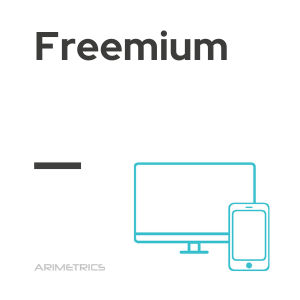Definition:
The term freemium is a fusion of the words “free” and “premium”. It refers to services, software or mobile applications that are offered free of charge to users, but with limited functionality. Additional and advanced features are available for a fee. This business model allows users to try the product or service without the need to purchase it outright. If users feel that the product or service meets their expectations, they are likely to choose to pay for the premium version. The freemium model is a popular strategy in the digital world, combining free access with paid options for advanced features. This structure allows companies to attract a broad user base by offering basic services at no cost.
Origin of the freemium model
The freemium model originated in the early 1990s, when software began to be marketed in a free format. An early example was AOL, which offered a free version of its online chat service to attract new users. Since then, the freemium model has been successfully applied to a wide range of digital products and services.
Advantages of the freemium model
The freemium model offers multiple benefits for both companies and consumers, facilitating access to services and fostering customer loyalty.
- Customer acquisition: Allows attracting new users without significant investment in advertising and promotion.
- Product testing: Users can test the product or service and evaluate its quality before committing to pay for it.
- Customer loyalty: Offers exclusive features and content for premium users, which helps build loyalty.
- Recurring income: Generate revenue through monthly or annual subscriptions.
- Market evaluation: Allows to get feedback from users and make improvements before an official launch.
Freemium, freeware and shareware are distinct models that offer free access, but differ in their approach and business objectives:
- Freemium: Offers a free basic version with the option to pay for a premium version that includes exclusive features. This model seeks to attract a broad user base with the free offering and convert some into paying customers by offering additional features.
- Freeware: It is completely free for all users, with no premium options or usage restrictions. This model is often used to increase brand recognition or to support a community of users.
- Shareware: Allows users to try the software free of charge for a limited period or with restricted functionality. After the trial, users are expected to pay to continue using the software or to unlock all of its features. This model allows users to evaluate the software before committing to purchase it.
Best known examples of freemium
Numerous companies have adopted the freemium model, taking advantage of its potential to expand their user base and generate sustainable revenues.
- Spotify: Offers free access to its music library with ads and certain limitations. The premium version removes ads and improves audio quality.
- Dropbox: Provides a limited amount of free storage space. Premium plans offer additional space and advanced features.
- LinkedIn: Offers free basic functions and premium plans with additional features for job search and networking.
- Zoom: Allows free meetings with time limitations. Paid plans offer longer meetings and additional features.
- Trello: Provides basic project management functionality for free. Premium versions offer advanced integrations and customization.
- Slack: Offers a free plan with limited message storage. Paid versions offer unlimited storage and advanced features.
- Canva: Allows you to create graphics with basic tools for free. Canva Pro offers premium resources and advanced editing tools.

